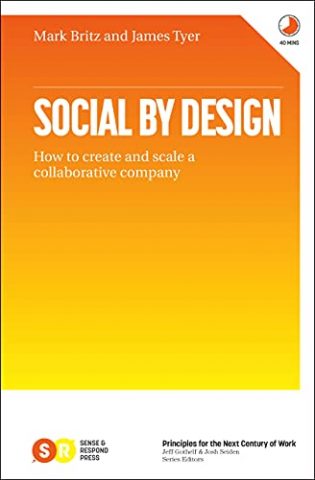Social By Design: A Book Review And Interview With Co-Author Mark Britz
Posted by Mitch Mitchell on Nov 9, 2021
It's been almost 6 years since I did my last book review. It's been 8 1/2 years since I did my last book review where I knew the author. Finally, it's been just over 10 years since I did my last interview on this blog; I've been slipping! Today, there's a little of both, which means I get to renew two birds with one article; bet you've never heard that one before. 🙂

Social By Design
Mark Britz & James Tyer
This probably isn't the type of book that I'd normally read, but Mark's a local friend of mine who convinced me to go to a restaurant to taste my first pierogi a few months ago (unfortunately, I wasn't a fan lol). I figured I owed him the respect to read his book, and I'm glad I did.
Basically, it deals with today's work environment and finding ways to open up communications between employees, each other and management. It discusses ways to open dialogue through electronic processes such as using platforms like Slack, finding new ways to open social learning and interactions, and allowing everyone to have a voice in a controlled environment to help organizations succeed and make sure everyone knows what's going on.
It's a different kind of conversation that's not commonly talked about. It's not specifically about policies and procedures in a office, which I've talked about often through the years. Instead, it covers more of the big picture, acknowledging that not only are employees looking for more information on what the company's doing, but also looking for ways to share their opinions on what's going on and offer their own ideas for solutions to help make the company better.
It's all about finding a balance between being social and still having processes in place to make sure the business is taken care of properly. It's more of a symbiotic process than a linear one, which is how most organizations operate in today's world.
As stated in the book, the chapters are a deep dive into out of 3 principles:
1. Social is uncontrollable
2. Conversation creates movement
3. People over technology
One very interesting statement is this:
Unfortunately, many well-intentional leaders who think they understand all of this begins with, "How do I get people to share more, talk more, collaborate?" They don't realize this too is control, even if more sincere. It can set the wrong course, one positioned more for inputs and outputs, not outcomes. The better question to ask is "How do we help or how do I help..."
Indirectly, it goes in a somewhat different direction of thinking about how to be a better leader than I've talked about for close to 20 years. My goal has always been about trying to help people become better leaders in order to help their employees be better and enjoy their jobs more by helping them concentrate more on their employees for their long term benefit and peace of mind.
I've never thought about it as control or manipulation of others, but in today's world it could be seen that way. After all, I've never thought about group social interaction as much as one on one interactions, with leaders making themselves available to employees and being seen as someone who has the employees best interest at an equal level as the interests of the organization. It's definitely something deeper to think about as the times have changed and employees these days are showing more often that they want to have a say in what's going on within the company they're working for.
The book covers more ground than one would expect for its size. There's only 66 pages, but it's a densely written book that, if it were a hardcover would easily be 100 pages or more. I'm not going to try to cover all of that, but I'm linking to the Amazon page where you can check out the book if you're interested in reading a bit more about it.
Meanwhile, it's time for the interview portion of this article. I wrote Mark after I read the book and first stated a few things, then asked some questions. This isn't a traditional type of interview; I rarely do anything the way someone else might do it. lol
His responses will be highlighted in yellow:
Thanks for allowing me to add some comments on things in your book. Don't worry; I'm not beating you up on anything; it's more like questions and light bulbs moments I had while consuming it.

Mark Britz
The first statement is in reference to this:
Effective organizational social connection... is like attending a great dinner party where the conversations are plentiful, diverse and ongoing, and the energy is high... and if it weren't for other commitments people would never leave.
First... you might not believe this but I've never been to a dinner party. I've seen them on TV, but I've never had the opportunity. This will sound weird to you, but I don't think most black families actually have dinner parties, per se. They might have holiday parties for times like Thanksgiving and Christmas, but I'm not sure those count. If they do, then I've been to one Thanksgiving dinner outside of family in my lifetime; that's it.
I think a holiday party analogy could have worked too or maybe better. The general idea is that one is strategic in making an environment conducive for connection, conversation and ultimately collaboration
Second, my mind was blown when I read early on about hospital design and how in its own way it was a contributory to the types of procedures physicians started doing on a more regular basis than they did before the redesign. I'd never thought about that end of the process, but I had thought about it about 30 years ago (ouch, my head!) when the hospital I was working for moved my billing department out of the facility and into a downtown location that they paid to have converted into office space.
Way beyond my field of expertise, I was tasked with designing the space for the employees who were going to work there, and the only references I had in my mind was what it was like working in a hospital office setting and what I saw when I got to visit the office of one of our collection agencies, which had cubicles that my mind thought was the coolest thing I'd ever seen. I have to admit that it cut down the noise factor dramatically, which was "kind of" a bonus, but it also limited the interaction between employees which in retrospect I'm not sure was a good thing.
Yes... every action has a reaction (not always positive?). What is that Newton's 3rd Law of motion?... it applies to people as much as inanimate objects. I think generally we don't tend to think in systems. We attack a problem and don't realize that our approach has a reproduction that was unexpected and maybe unwelcome. We are so eager to fix that we don't pause and say... "what will this fix do to the rest of the system?
Third, and I think I've mentioned this to you here and there over the years though you might not remember it, but often I've seen you write things and think to myself "I have no idea what that means". lol Even when I tried reading your blog I was totally confused; I think I had a mental block because my mindset in health care and leadership is linear, not exploratory or... what... big picture thinking, outside the box, paradigms (remembering an old commercial where the guy pronounced it as para-dig-em lol), etc. After I got past the first few pages I started understanding it all because of the examples... though I've always had problems understanding diagrams, and that didn't change here... which is totally on me. I might have needed Kermit the Frog or Winnie the Pooh to help me with those. lol
I guess in the end the book was not written for you. It wasn't written for a lot of people... most people. It was written for people in a particular situation that saw what was/is happening in their organizations wasn't working or wasn't heading in the right direction. So it's very niche but that's OK by me!
With that stuff said, onto questions and possibly commentary.
We've seen what's happening throughout the country with the conversation about the Covid vaccines; it's been ugly and polarizing. In the book it's mentioned that some conversations won't go smoothly, but companies shouldn't be scared of conversations on a delicate subject, while also being willing to moderate or delete certain types of conversation. How would you recommend those types of conversations be handled, especially in organizations that mandate employees must be vaccinated?
I believe we have to have them open but set guidelines that everyone respects. The idea that if you cross the line into disrespecting another, you're shut down. Doesn't matter what side its on... these are the rules of the road. A good debate has rules so that it's not chaos. Online in organizations that's governance and it's necessary.
I mentioned my mindset as it concerned physical design in hospitals, but other companies do the same thing. Two part question: a) Do you believe a more open design would work better across the board, and if so, would you go as far as the type of setup in co-working spaces; b) if you're limited by both physical restraints and the need for confidential areas (patients confidentiality), do the needs of the consumers overrule the needs of the employees?
A. I am not an advocate for the physical open office concept. Honestly in many ways it was less about creating transparency than reducing costs (individual offices are expensive). An open office isn't about space as much as it's about information being accessible, people being accessible, about a reduction in rigid hierarchy. This is about systems change however, not removing walls.
B. Yes. In the end the motive of any organization is to remain viable... profitable or in the case of a not-for-profit, meeting the community needs. That can't be jeopardized. The risk however is in not having the right balance or recognizing when rules are overbearing and negatively impacting consumers
I was intrigued by your examples of guidelines versus policies/protocols. I've always been a policies and procedures guy when it came to work processes so employees would have a resource to go to if they had questions they needed answers to when it came to processes. I assumed the guidelines you talked about were on platforms like Slack or any other kind of internal source of that ilk, but I wanted clarification if you think that sort of thing can work across the board within an organization?
I was definitely talking about social guidelines but I'm happy that it made you think how it could be used and beneficial in other areas. TBH, Policy is important of course. Having standard practices creates uniformity in services, meeting expectations continually, it can create equity, etc. I'd argue though that, like we say in the book, you must have a sniff test like in older fridge food. We need to be sure that what we had is not spoiled. Times change, needs change for individual and organization.
As you know, I write and talk a lot about leaders and leadership. Not only did I have an open door policy, but every work day I got out of the office for a while and walked among the employees, giving them the opportunity to see me, talk to me and ask questions if they were so inclined. I even talked to employees who didn't work for me; in essence, I got along with "almost" everybody because a few supervisors didn't necessarily like it, but there wasn't anything they could do about it since I didn't walk into their departments and start those conversations. If you were working with an organization that didn't have an electronic platform for discussions, do you think encouraging more leaders (those who could mentally handle it) to do that sort of thing would help with social, or do you think those days are gone, and in general wouldn't have worked for all that many people?
Every org is different as are the people within.. But innately, humans are social creatures. We want to share and connect, it's our org systems and capitalism over all of it that prevents us... these systems create competition and competition is the enemy of collaboration. A leader who walks the walk, talks the talk and is close to the employee base sends a signal of "This is important behavior."
I totally agree with you on the folly of adoption made by leaders who don't understand the concept of social engagement... which I hate to say is the majority of leaders. Over my years in health care, I've counseled most of them that just adding new technology in any manner doesn't solve the issues of employees or anyone else. How would you handle something like that?
There are plenty of tech examples to draw from as examples. Take project management software. Merely having the software doesn't make one a project manager... as social tech won't make people social. We use an innovation matrix in the book that represents this in 4 quadrants. How a revolutionary tech coupled with traditional thinking (management) will only lead to incremental change. It's a great tool to sketch on a napkin and discuss 🙂
This is a good place to stop the review and the interview; otherwise it could end up being longer than the book. If you'd like to reach Mark you can find him at Social By Design Solutions, on LinkedIn, or on Twitter, where we interact with each other all the time. You can also check out Mark's article and take on our email conversation, which he posted here on LinkedIn.

